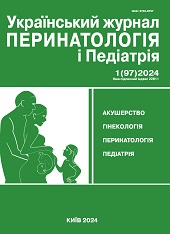Determination of the volume of blood loss in prenatal and postnatal obstetric bleeding (clinical cases)
DOI:
https://doi.org/10.15574/PP.2024.97.117Keywords:
obstetric bleeding, prenatal bleeding, postpartum bleeding, visual assessment of bleeding, quantitative assessment of bleeding, cesarean section, maternal mortalityAbstract
Purpose - to analyze the amount of blood loss in prenatal and postpartum obstetric bleeding based on clinical cases. During the period from 2020 to 2022, on the basis of the Communal Enterprise «Regional Medical Center of Family Health» in Dnipro, an algorithm for quantitative determination of blood loss was implemented.
Clinical case 1. A 38-week pregnant woman was admitted with complaints of slight bleeding from the genital tract, which was not accompanied by pain. Diagnosis: «II pregnancy 38 weeks». The main presentation. Placenta previa (signs of placental abruption). Initially, blood smears up to 50.0 ml were determined. After 2 hours, blood loss was repeated and estimated at 250.0 ml (total blood loss 300.0 ml). Consilium decided to perform cesarean section (C-section). A girl was born, weighing 3450 g, with an Apgar score of 7/8. The total blood loss after KR was 850.0 ml.
Clinical case 2. The pregnant woman entered the hospital for delivery with a diagnosis: 3rd pregnancy of 36 weeks, placenta increta (invasion of the placenta into the muscular layer of the uterus), for C-section, During C-section, placental invasion through the uterine muscle layer into the bladder was diagnosed. The total blood loss after the operation was 5870.0 ml. The main complication in this case is usually a massive bleeding. To control the volume of blood loss, a protocol was used to quantify the amount of blood loss with the calculation of the rate of bleeding per minute, which helped both obstetricians to control the stages of surgical treatment and anesthesiologists to consider infusion-transfusion therapy in relation to the degree of blood loss.
Conclusions. In those cases when doctors control bleeding up to 250.0 ml, they use a visual method of assessing blood loss, more often this is the case with prenatal bleeding. In other cases, it is advisable to use a quantitative assessment of postpartum blood loss, this largely determined the timeliness of obstetric care, the implementation of balanced intensive infusion-transfusion therapy, the reduction of blood loss volumes, which led to the minimization of the use of donor blood preparations, and organ-preserving technologies were more often used in the provision of emergency care for obstetric bleeding.
The study was performed in accordance with the principles of the Declaration of Helsinki. Informed consent of women was obtained for the study.
No conflict of interests was declared by the author.
References
ACOG. (2019). Quantitative assessment of blood loss in obstetric bleeding. Recommendations of the ACOG Obstetric Committee. URL: https://www.acog.org/media/project/acog/acogorg/clinical/files/committeeopinion/articles/2019/12/quantitative-blood-loss-in-obstetric-hemorrhage.pdf.
Butwick AJ. (2015). Transfusion and coagulation management in ma- jor obstetric hemorrhage. Curr. Opin. Anesthesiol. 28; 3: 275-284. https://doi.org/10.1097/ACO.0000000000000180; PMid:25812005 PMCid:PMC4567035
Collis R. (2017). Managing major obstetric haemorrhage: Pharmaco- therapy and transfusion. Best Pract. Res. Clin. Anaesthesiol. 31; 1: 107-124. https://doi.org/10.1016/j.bpa.2017.02.001; PMid:28625299
Cunningham FG, Leveno KL, Bloom SL et al. (2005). Williams Obstetrics. 22th ed. New York: McGraw-Hill.
Dubossarskaya Yu. Lebedyuk V. (2017). Obstetric bleeding. Algorithm of emergency care. Preventive measures. Guidelines. Dnipro.
Golyanovsky OV, Mehedko VV, Savonik AA, Goncharenko DO, Kucher VM et al. (2018). Innovation of delivery of pregnant women with an abnormally invasive placenta: placenta percreta (case of practice). Health of woman. 6 (132): 19-24. https://doi.org/10.15574/HW.2018.132.19
Kaminsky VV, Chernov AV, Golyanovsky AV. (2014). Postnatal blood loss: evaluation features, true indicators and the problem of unified definition. Health of woman. 10: 29-32.
Knight M, Kenyon S, Brocklehurst P et al. (2014). Saving lives, improving mothers' care. Lessons learned to inform future maternity care from the UK and Ireland Confidential Enquiries into Maternal Deaths and Morbidity Oxford: National Perinatal Epidemiology Unit, University of Oxford. 2009: e2012.
Lebediuk VV. (2023). Determination of blood loss volume in obstetrics hemorrhages. XII International Scientific and Practical Conference «Challenges in science of nowadays». December 6-8, 2023 in Washington, USA: 306-310. URL: https://archive.interconf. center/index.php/conference- proceeding/issue/archive.
Tanimura K, Morizane M, Deguchi M, Ebina Y, Tanaka U, Ueno Y et al. (2018, Apr). A new scale for predicting placenta accreta in women with placenta previa. Association of Obstetricians and Gynecologists, Association of Radiologists, Japan. Dzherelo. A novel scoring system for predicting adherent placenta in women with placenta previa. Placenta. 64: 27-33. Epub 2018 Mar 2. https://doi.org/10.1016/j.placenta.2018.02.005; PMid:29626978
Downloads
Published
Issue
Section
License
Copyright (c) 2024 Ukrainian Journal of Perinatology and Pediatrics

This work is licensed under a Creative Commons Attribution-NonCommercial 4.0 International License.
The policy of the Journal “Ukrainian Journal of Perinatology and Pediatrics” is compatible with the vast majority of funders' of open access and self-archiving policies. The journal provides immediate open access route being convinced that everyone – not only scientists - can benefit from research results, and publishes articles exclusively under open access distribution, with a Creative Commons Attribution-Noncommercial 4.0 international license(СС BY-NC).
Authors transfer the copyright to the Journal “MODERN PEDIATRICS. UKRAINE” when the manuscript is accepted for publication. Authors declare that this manuscript has not been published nor is under simultaneous consideration for publication elsewhere. After publication, the articles become freely available on-line to the public.
Readers have the right to use, distribute, and reproduce articles in any medium, provided the articles and the journal are properly cited.
The use of published materials for commercial purposes is strongly prohibited.

